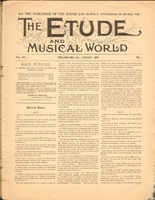[Our subscribers are invited to send in questions for this department. Please write them on one side of the paper only, and not with other things on the same sheet. In Every Case the Writer’s Full Address must be Given, or the questions will receive no attention. In no case will the writer’s name be printed to the questions in The Etude. Questions that have no general interest will not receive attention.]
Mrs. W. T. D.—A phrase beginning in the middle of the measure and continuing into the next does obliterate, to a great extent, the accent which is usually given the first beat of the measure.
C. C.—There is no such a thing as an American or German School of Pianoforte Playing, hence I cannot tell you where they differ. Do you not refer to mode of fingering or school of composition?
C. S.—Una Corda means one string, which on grand pianos means to use soft pedal. The action, when the foot is placed on soft pedal moves to one side, so that hammer strikes one string instead of three. On upright pianos the stroke is lessened or shortened, but all the keys are struck; on square pianos a piece of felt comes between the hammer and string. By common usage the term “Una Corda” applies to all pianos when the soft pedal should be used. It must be remembered that in Europe the grand piano is almost in universal use, as was the square in this country twenty-five years ago. For the pronunciation of proper names see Clarke’s Dictionary.
W. H.—1. Carl Baerman lives in Boston. He can be addressed care of Chickering & Sons.
2. The figures in Thorough Bass indicate the intervals to be played from the actual bass note; thus 6-4-3 on D means that a sixth, a fourth, and third must be written from D. It does not mean that the third is to be first after D and the fourth next and the sixth the highest. The order in which they are written depends on what came before and what is to follow. 3. The D in the 16th measure of “Star of Hope” is not tied as in the original organ arrangement because it cannot be prolonged as on the organ and must be struck again. 4. The long chromatic run, same piece, is never played in strict time. It is impossible to divide it up mathematically; play in its place a glissando or any other ornament till you get the swing. It will then be easy enough to play if you have the technic. There will always be a fluctuation of time in this particular passage. Please do not ask for private information.
C. M. D.—“Pfingst” cantata of Bach, or as it was originally named Feria II. Pentecostes, is the German for “Feast of Pentecost” or Whitsuntide.
Miss Lizzie Chaminade in reply to the query how she composed, said:
“Sometimes traveling, sometimes at the piano, often at my table, but never in the morning. I must gradually warm to my work. I prelude for ten days or a fortnight, and when the ideas come I set to work. I cannot work to order, but only by fits and starts.”
D.—1. For the meaning of the word “climax” we would refer you to any good dictionary. The word has no distinctive musical meaning.
2. The third part of Rubinstein’s “Kamennoi Ostrow” in which the melody is embellished by arpeggios, is played in the same tempo as the first part.
3. The phrases in the Adagio of Beethoven’s Sonata, Op. 2, No. 1, are two measures each; however, the third phrase is four, according to Reimann. We would advise you to get this edition of the Sonata as one giving special attention to the phrasing.
4. The circle used in the thirteenth measure of Bach’s Second Invention, Schirmer Edition, simply indicates that the note is not held its full value; it is cut short by the embellishment in the left hand, which plays the same note.
Paganini.—There is no complete published list of the musical institutions in the United States.



